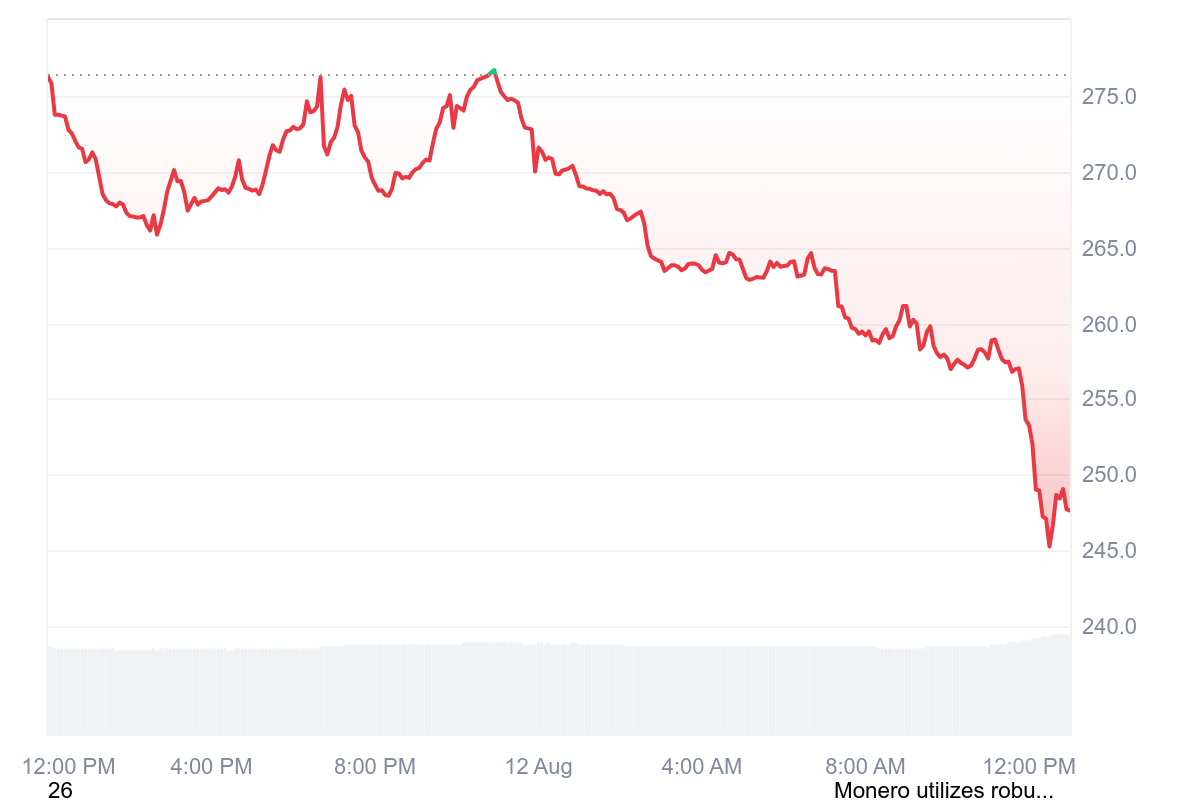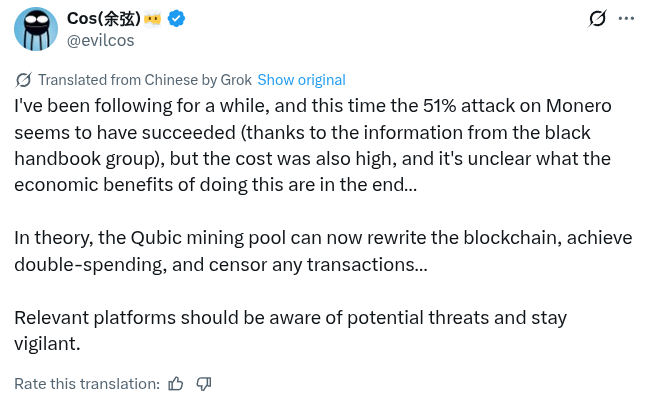Monero has experienced a significant disruption with 60 blocks discarded in 24 hours due to a 51% attack by Qubic, raising concerns about network security.
-
60 blocks discarded: Monero faced 60 orphaned blocks in the last 24 hours.
-
51% attack claimed: Qubic’s founder claims the mining pool has achieved a 51% control over Monero.
-
Economic attack: Qubic miners are incentivized to mine Monero and sell proceeds for Qubic tokens.
Monero faces a significant threat from Qubic’s selfish mining tactics, leading to a 51% attack and concerns over network integrity.
| Event | Details | Impact |
|---|---|---|
| Discarded Blocks | 60 blocks in 24 hours | Network disruption |
| 51% Attack | Claimed by Qubic | Transaction manipulation risk |
What is a 51% Attack?
A 51% attack occurs when a single entity controls over half of a blockchain’s mining power, allowing them to manipulate transactions and potentially double-spend coins.
How Does Selfish Mining Work?
In selfish mining, miners withhold blocks to gain an advantage over the public chain, leading to orphaned blocks and potential network disruption. This tactic is currently being employed by Qubic against Monero.
Frequently Asked Questions
What are the implications of a 51% attack on Monero?
A 51% attack on Monero could lead to transaction manipulation, double-spending, and loss of trust in the network.
How does Qubic’s attack affect Monero miners?
Qubic’s attack has created an economic incentive for miners to switch to Qubic, potentially reducing Monero’s overall mining power.
Key Takeaways
- Network Vulnerability: Monero is currently facing significant risks due to Qubic’s attack.
- Economic Incentives: Qubic miners are incentivized to undermine Monero’s network.
- Community Response: Ongoing discussions about countermeasures are crucial for Monero’s future.
Conclusion
Monero’s recent challenges highlight the vulnerabilities in blockchain networks. As Qubic’s selfish mining tactics escalate, the community must remain vigilant and proactive in safeguarding the integrity of the network.
Monero suffered 60 discarded blocks in 24 hours as Qubic openly conducts selfish mining and claims a successful 51% attack, escalating an ongoing hack war.
The privacy-focused cryptocurrency Monero has suffered a major disruption, with 60 mined blocks discarded from its blockchain in the past 24 hours amid an ongoing attempted 51% attack by the Qubic network.
The Monero Consensus Status dashboard shows Monero saw 60 orphaned blocks (valid blocks that were rejected) in the last 720 blocks. The disruption comes amid an ongoing economic attack by the Qubic network, incentivizing selfish mining.
Qubic miners redirect their computing power to mine Monero (XMR) and sell the proceeds to buy and burn Qubic tokens, while being paid in QUBIC. Qubic miners reportedly earn more than Monero miners under this setup.
The attack has sparked fears of a possible “51% attack” — a rare and serious event that can let attackers rewrite transactions or block them entirely.
An orphaned block is a valid block excluded from the main chain because another competing block at the same height was accepted first. In selfish mining, a miner with significant hashrate withholds blocks and publishes them strategically to overtake the public chain, causing honest miners’ work to be discarded.
As of the time of writing, Monero’s price stands at over $247, down over 8.6% from the price of over $276 reported 24 hours ago.

Monero’s 24-hour price chart. Source: CoinMarketCap
Qubic attack disrupts Monero network
Qubic’s Monero mining pool openly engages in selfish mining, with Qubic founder Sergey Ivancheglo admitting it in an X post. Ivancheglo claimed in a Tuesday X post that “Qubic has achieved 51% over Monero” and the team is “waiting for independent confirmations.”
A 51% attack occurs when a single entity — in this case, the Qubic mining pool — controls over half of a blockchain network’s mining power or stake, allowing them to manipulate transactions. Zhong Chenming, the co-founder of crypto cybersecurity firm SlowMist, said in a Tuesday X post that “this time the 51% attack on Monero seems to have succeeded.” He added:
“The cost was also high, and it’s unclear what the economic benefits of doing this are in the end… In theory, the Qubic mining pool can now rewrite the blockchain, achieve double-spending, and censor any transactions.”

Source: Zhong Chenming
Not everyone is convinced
Doubts remain around whether a successful 51% attack occurred. Engaging in selfish mining with control over a high percentage of the hashrate that is short of the majority can occasionally lead to orphaned blocks.
Monero’s total hashrate evaluation by CoinWarz results in a 5 GH/s estimation. Unverified data provided by Qubic claims a peak hashrate of 3.01 GH/s, which is more than sufficient, and a current hashrate of 2.08 GH/s, insufficient for a 51% attack.
The Monero Consensus Status also indicates that the number of blocks mined by unknown mining pools and solo miners — the category which includes Qubic — reached nearly 30% on Aug. 11. This could signal Qubic controlling most of the hashrate for a brief period, or controlling a significant portion but still a minority of the hashrate.
SeraiDEX’s lead developer, Luke Parker, raised an issue with reports that a 51% attack took place in a separate X post. He noted that a six-block-deep network reorganization with block orphaning “does not mean a ‘51% attack’ was successful.”
“It does mean an adversary with a high amount of hash got lucky,” he added.
Hack war escalates between networks
Qubic and Monero are locked in an ongoing hack war, trading countermeasures. Ivancheglo previously wrote on X that Monero broke Qubic’s selfish mining system, prompting his fix. Before that, Ivancheglo accused a developer of Monero mining software XMRig, Sergei Chernykh, of denial-of-service (DDoS) attackg Qubic’s pool, leading to hashrate losses — a claim Chernykh disputes.
The attack first started in late July when the community noticed what it described as an “economic attack.” The operation uses economic incentives — paying Qubic miners more than Monero miners — in an attempt to take control over most of Monero’s hashrate and consequently the network.
Niko Demchuk, head of legal at onchain forensics firm AMLBot, told Cointelegraph that Qubic’s attack on Monero could be deemed “computer sabotage” or “unauthorized access” under Belarusian and European Union laws. However, no statute explicitly mentions 51% attacks. Demchuk said Belarus’ cybercrime rules could apply if blockchain manipulation disrupts protected systems.
Magazine: Bitcoin vs. the quantum computer threat: Timeline and solutions (2025–2035)
